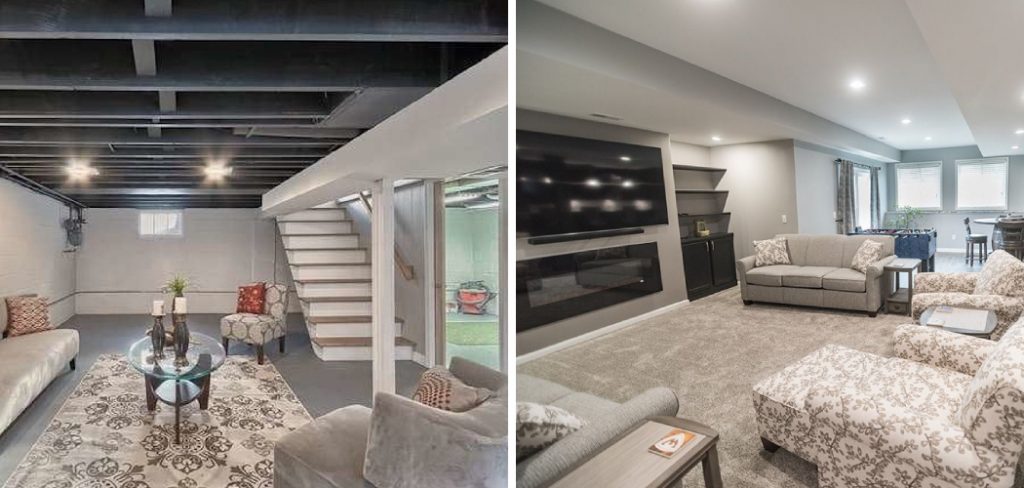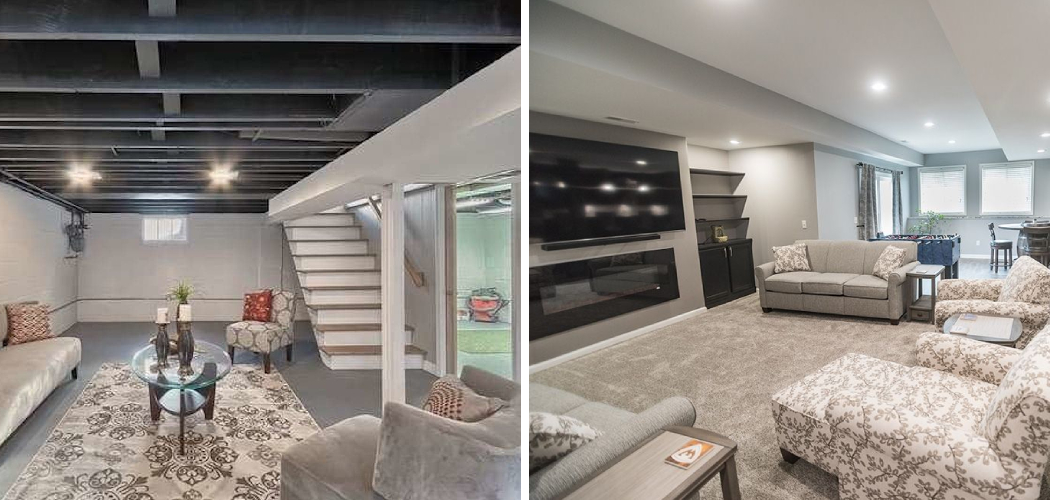Finishing a basement with a low ceiling presents unique challenges but also offers an opportunity to transform an often-overlooked space into a cozy and functional area.
This guide on how to finish a basement with a low ceiling will walk you through the essential considerations and innovative solutions for making the most of your basement’s limited headroom.

From selecting the right materials and colors to clever lighting and furniture choices, you’ll discover how to create an inviting atmosphere that defies spatial limitations. Whether you’re aiming for a comfortable living space, a home office, or a recreational area, our tips will help you maximize the potential of your basement, turning it into a cherished part of your home.
What is a Ceiling Basement?
Before we dive into the specifics of finishing a basement with a low ceiling, let’s define what we mean by “low ceiling.” In general, basements with ceilings below seven feet are considered low-ceilinged. This can be due to factors such as ductwork, pipes, and beams that limit the overhead space.
A cramped and uninviting basement can make you feel like you’re in a cave, but with the right techniques and strategies, you can transform it into a comfortable and attractive living area.
The key is to work with the existing layout and features of your basement rather than trying to cover them up or tear them down. Keep in mind that a low ceiling can also bring a cozy and intimate feeling to a room, so embrace its uniqueness and use it to your advantage.
Choosing the Right Materials
When it comes to finishing a basement with a low ceiling, material selection is critical. Here are some key factors to consider:
Use Low-profile Flooring:
Opt for materials like laminate, vinyl, or low-pile carpet that won’t add too much height to your floor.
Avoid Bulky Furniture:
Stick to sleek and streamlined pieces that won’t take up too much vertical space.
Consider Drop Ceilings:
These can be installed below the existing ceiling, giving you more headroom while also allowing access to pipes and wiring.
Use Light Colors:
Light-colored walls and ceilings can create the illusion of height and make a space feel brighter and more open. Avoid dark colors that can make the room feel smaller and more cave-like.
10 Step-by-step Guidelines on How to Finish a Basement With a Low Ceiling
Step 1: Measure the Ceiling Height
Before you begin any renovations, it’s crucial to take accurate measurements of your basement’s ceiling height. This will help you understand the spatial limitations you’re working with and inform your decisions on materials, lighting, and furniture.

Use a measuring tape to find the height from the floor to the lowest point of the ceiling, taking note of any variations due to pipes, ductwork, or beams. Documenting these measurements will be invaluable as you move forward with your basement transformation project.
Step 2: Create a Plan
With your measurements in hand, it’s time to create a plan for your basement. Consider how you want to use the space and what features are already in place that may affect the layout (e.g., support beams, electrical panels).
This is also an excellent opportunity to consult with a professional contractor or designer who can offer expert advice and help you avoid costly mistakes.
Step 3: Address Any Moisture Issues
Before proceeding with any cosmetic enhancements or structural modifications, it’s imperative to tackle any existing moisture problems in your basement. Moisture can lead to mold, mildew, and structural damage, which can be particularly concerning in a space with limited ventilation.
Start by inspecting the exterior of your home for any signs of water damage or leaks, especially around the foundation.
Ensure that gutters and downspouts are directing water away from the building’s foundation. Inside, consider applying a waterproofing sealant to the basement walls and floor. If high humidity levels are a concern, installing a dehumidifier can help maintain a more comfortable and healthier environment.
Addressing these moisture issues early on will protect your investment and ensure that your finished basement remains dry and comfortable for years to come.
Step 4: Install Adequate Lighting
Basements with low ceilings often suffer from poor lighting, which can make the space feel even more cramped and uninviting. Installing proper lighting is key to creating a bright and welcoming atmosphere.
Consider utilizing recessed lighting instead of traditional fixtures, as they take up less vertical space. You can also use floor lamps or wall sconces to add additional layers of light.

Step 5: Consider Built-in Shelving
Maximizing storage while maintaining a sense of openness in a basement with a low ceiling can be achieved through the use of built-in shelving. Built-ins provide a seamless storage solution that can be customized to your space, allowing you to utilize every inch efficiently.
Opt for shallow shelves to avoid protruding too much into the room, and consider extending your shelving up to the ceiling to draw the eye upwards and create the illusion of height. When planned carefully, built-in shelving can also incorporate recesses for lighting or hide unsightly beams and pipes, further enhancing the aesthetic and functionality of your basement space.
Step 6: Use Mirrors
Incorporating mirrors into your basement design can dramatically alter the perception of space, making a low-ceilinged room appear larger and more open.
Mirrors reflect both natural and artificial light, effectively doubling the light’s presence and helping to brighten the entire area. When strategically placed opposite windows or light sources, mirrors can enhance the illusion of depth and height in your basement.
Consider large, wall-mounted mirrors for a more significant impact, or arrange a series of smaller mirrors to create a stylish feature wall. This trick not only adds a decorative touch but also plays a crucial role in overcoming the limitations imposed by a low ceiling.
Step 7: Choose the Right Paint Color
As mentioned earlier, light colors are your best friend when it comes to finishing a basement with a low ceiling. Even if you’re a fan of bold and dark shades, it’s essential to resist the temptation in a low-ceilinged space.
Dark colors absorb light and can make the room feel smaller and more claustrophobic. Instead, opt for neutral tones like white, cream, or pale grey to create a sense of openness and airiness.

Step 8: Consider the Ceiling
When it comes to finishing a basement with a low ceiling, many homeowners struggle with what to do about the ceiling itself. If you’re not a fan of drop ceilings, there are still several options that can help you create a stylish and functional overhead space.
Drywall is an excellent option for basements with low ceilings, as it doesn’t hang too far down and still allows access to plumbing and wiring. You can also consider adding ceiling beams or using decorative paneling or tiles to add texture and depth.
Step 9: Use Furniture Wisely
When furnishing your basement, stick to sleek and streamlined pieces that won’t take up too much vertical space. Avoid bulky furniture and opt for low-slung couches, chairs, and tables instead. Multi-purpose furniture is also a great option for maximizing space in a small basement.
Consider using storage ottomans or bookshelves with built-in seating to save on both floor and vertical space. You can also use furniture to create designated areas within your basement, such as a cozy reading nook or a gaming corner.
Step 10: Add Personal Touches
Lastly, don’t forget to add personal touches and decorative elements that make your finished basement feel like a welcoming and comfortable living space. Hang artwork or photos on the walls, add throw pillows and blankets to your seating area, and incorporate plants or other natural elements to bring life into the room.
These small details can make a big impact and help transform your basement into a functional and inviting space for you and your family to enjoy.
Following these steps on how to finish a basement with a low ceiling will help you maximize the potential of your basement, even if it has a low ceiling. With careful planning, addressing moisture issues, and incorporating design elements that create an illusion of space and light, you can transform your basement into a beautiful and functional addition to your home.
So get started on your basement transformation project today – the possibilities are endless!
Implementing Safety Measures and Building Codes
Ensuring your basement renovation project adheres to local building codes and safety standards is essential. Before you begin any work, familiarize yourself with the relevant regulations in your area.

This may include obtaining permits for electrical and plumbing work, as well as ensuring that any structural changes meet building codes. It is also crucial to install smoke and carbon monoxide detectors in your basement to ensure the safety of your family.
Proper egress windows are a must in case of emergency; these windows provide a safe exit route and also allow for natural light to enter the space. Ventilation is another critical factor; ensuring adequate airflow can prevent the buildup of harmful gases and maintain a healthy living environment.
Taking these steps not only ensures that your basement is safe and compliant but also adds value to your home by meeting established safety standards.
Cost Considerations and Budgeting
When undertaking a basement finishing project, especially in a space with a low ceiling, budgeting becomes a critical component.
The overall cost can be influenced by various factors, including the need to tackle moisture issues, the type of materials chosen, and whether structural changes are required. It’s essential to set a realistic budget from the start, factoring in not just the visible changes but also unseen aspects like insulation and waterproofing.
To ensure you stay within budget, start by getting multiple quotes from contractors who have experience with basements similar to yours. Itemize your project into must-haves and nice-to-haves to prioritize spending.
Remember, investing in moisture control and adequate lighting can prevent costly repairs or adjustments in the future. Additionally, consider the long-term savings that efficient lighting and insulation materials can offer.
It’s also wise to allocate a contingency fund, typically 10-20% of your total budget, for unexpected expenses. Projects often uncover hidden issues once work begins, and having a financial cushion can help manage these surprises without derailing your project.
By carefully planning and budgeting, you can create a functional and beautiful basement space that adds value to your home without breaking the bank.
Inspirational Examples and Case Studies
When considering a basement renovation, especially in a space with limitations such as a low ceiling, it’s helpful to draw inspiration from successful transformations. Here are a few inspirational examples and case studies that demonstrate how strategic design and thoughtful planning can overcome common basement challenges.
Case Study 1: The Cozy Retreat

This homeowner transformed a once-cramped basement with a low ceiling into a cozy family retreat. By selecting light colors for walls and ceilings and incorporating recessed lighting, they were able to create the illusion of a higher ceiling.
The strategic use of mirrors further enhanced the sense of space, making the basement appear larger and more inviting. Sleek, low-profile furniture ensured that the area remained uncluttered, emphasizing the open feel.
Case Study 2: The Modern Home Office
Faced with the challenge of creating a productive workspace within a low-ceiling basement, this case study showcases the importance of natural light and minimalistic design.
A wall was replaced with a large egress window, not only to meet building codes but to flood the space with natural light, dramatically transforming the ambiance.
Modern, simple furniture pieces and built-in shelves maximized floor space without overwhelming the area, demonstrating how a basement can become a bright and efficient home office.
Case Study 3: The Entertainment Hub
Turning a low-ceiling basement into the ultimate entertainment hub required innovative solutions in this example. Acoustic ceiling tiles were chosen to enhance sound quality without reducing ceiling height.
Ambient and task lighting were carefully designed to illuminate key areas without overpowering the space. Incorporating a combination of built-in cabinetry and open shelving allowed for ample storage and display areas, keeping the entertainment gear organized and accessible without sacrificing style.
Each of these case studies underscores a common theme: creative problem-solving and attention to detail can transform even the most challenging basement into a beautiful, functional space.
Whether you’re dreaming of a relaxing family area, a productive office, or an entertainment paradise, these examples prove that with the right approach, your basement’s potential is limitless.
Frequently Asked Questions
Q1: What Should I Do Before Starting a Basement Renovation Project?

A: Before beginning any work, familiarize yourself with local building codes and safety standards. Obtain necessary permits and install safety measures such as smoke and carbon monoxide detectors. Most importantly, a realistic budget and plan for potential surprises should be established by setting aside a contingency fund.
Q2: How Can I Ensure My Basement Renovation Stays Within Budget?
A: Start by getting multiple quotes from experienced contractors. Make a realistic budget that includes hidden costs like insulation and waterproofing, prioritize spending on must-haves and allocate a contingency fund for unexpected expenses.
Q3: How Can I Overcome the Challenge of a Low-Ceiling Basement?
A: Strategic use of light colors, mirrors, and recessed lighting can create the illusion of a higher ceiling. Incorporating natural light through egress windows or skylights can also dramatically transform the space. Utilizing sleek and simple furniture pieces and built-in storage can also maximize space without overwhelming the area.
Q4: What Are Some Common Uses for a Finished Basement?
A: A finished basement can serve as an additional living space, such as a family room or home theater. It can also function as a guest suite, home office, gym, or playroom. The possibilities are endless and depend on your needs and lifestyle. The key is to plan and design the space accordingly.

Conclusion
In conclusion, transforming a basement with a low ceiling into a vibrant, functional space is entirely within reach with the right strategies.
By addressing moisture control, optimizing lighting, choosing appropriate furniture, and implementing design tricks to create the illusion of height, you can turn what might seem like a challenging area into one of your home’s most beloved spaces. Remember, the key to a successful basement renovation lies in careful planning, thoughtful design, and attention to detail.
With a bit of creativity and the right approach, your low-ceiling basement can become a cozy retreat, an entertainment area, or a productive workspace that adds significant value and comfort to your home. Keep in mind that budgeting wisely and preparing for unexpected challenges will help ensure a smooth renovation process.
By following these guidelines on how to finish a basement with a low ceiling, your basement project can surpass expectations, proving that even the most compact spaces can be transformed into something extraordinary.
